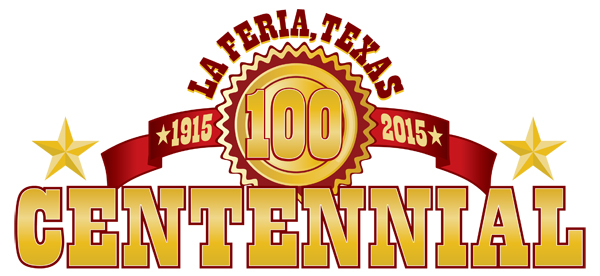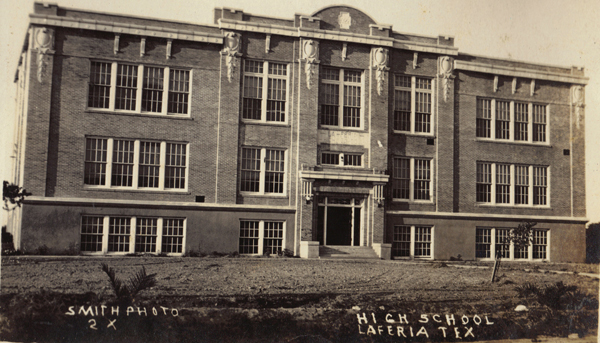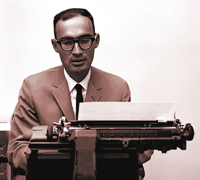- La Feria Community Holds Succesful Business Mixer Event
- Little Nashville to Take Place in Downtown Mercedes
- Lions Basketball Captures District Gold
- La Feria ISD Students Compete in Regional Chess Tournament
- Lions End First Half of 32-4A on a High Note
- La Feria ISD Held Another Successful Parent Conference
- Strong Appearance for Lions at Hidalgo Power Meet
- LFECHS Students Get to Meet Local Actress
- Students Participate in Marine Biology Camp
- Two LFECHS Students Qualify for All-State Band
What Libraries Can Do
- Updated: May 22, 2015

The city of La Feria is celebrating its 100th year anniversary and to commemorate the occasion we are digging deep into our archives each week to bring you images and stories from La Feria’s colorful past.
The following is part of a series of historical articles written by Michael Lamm that originally ran in the La Feria News in 2003. They are being reprinted with the author’s permission.

In the 1950’s La Feria High School housed the only library in town.
La Feria had no municipal library back in the 1950s, but there was a library of sorts in our high school. It wasn’t much of a library; just the back part of our study hall. The library portion of this room was separated by a counter and had maybe two rows of stacks plus additional shelves on three walls.
Books were mostly things like Mark Twain and Jack London, some Nancy Drew mysteries, Thorne Smith novels, stuff kids liked. I read most of those books passing the time in study hall. That’s what they were for. But then one day, almost by accident, I discovered the real treasures of our high school library: dusty old magazines.
These were bundled by title and year, each neatly tied with brown twine. The majority were magazines of the 1930s. Apparently some enterprising librarian had sorted these magazines and arranged them for posterity. I happened to be that posterity, and what got me interested in the old issues of Time, Life, Fortune, The Saturday Evening Post, Colliers, etc., were the car ads.
As I’ve mentioned before, I was thoroughly smitten by automobiles by the time I entered high school, and more than anything else I wanted to learn everything I could about cars. Also, to me the most beautiful cars ever built were those of the early 1930s, particularly 1932 models, and this remains an opinion I still hold today.
Well, I began with Fortune, undoing each neatly tied bundle and starting with the premier issue in 1930. Fortune had the most gloriously opulent classic car ads ever created, many of them in color at a time when most magazines printed only black and white.
I use the word “classic” with some reservation, because in the 1950s, automobiles of the 1930s were plainly and simply used cars. The concept of classic cars was in its infancy. Duesenbergs, Auburns, Cords, Packards, Pierce Arrows, 16 cylinder Cadillacs, LeBaron Imperials and coachbuilt Lincolns were often drugs on the market, relegated to the back rows of used car lots. Even so, to me they were very beautiful and special, and I spent many hours in study hall poring over the richly illustrated, wonderfully luxurious ads in Fortune.
I even did the unthinkable: I took my pocket knife and razored out a lot of those ads, smuggled them home and pasted them in a scrapbook. Today, I’d kill a kid if I caught him doing that, but if it’s any consolation, I still have the scrapbooks.
Once I’d ravaged Fortune, I moved on to Time and Life. The cars and car ads in those two magazines weren’t nearly so luxurious, but they did give me a sense of how auto manufacturers pitched their products to ordinary citizens. Here were ads for Fords, Chevys, Plymouths, Dodges, Hudsons, Willys, Grahams, Studebakers and so forth, each trying desperately to weather the Great Depression.
Going through Time and Life magazines of the 1930s, I couldn’t help but discover the history of that decade. In my quest for car ads, my eye caught pictures of men smashing whiskey casks, men standing in bread lines, men camped alongside railroad tracks…also such events as the shooting of Chicago’s Mayor Cermak, the Hindenburg blaze, President Roosevelt at his desk and in open cars, Hitler and Mussolini coming to power… the events of the Depression leading up to World War II. I would be stopped by the photo, read the caption and then the article, not because a teacher had assigned it but just because it fascinated me.
Nor were Colliers or the Post safe from my knife. National Geographic didn’t carry ads in those days, but I flipped through great stacks of them anyway, looking for pictures of bare-chested women from Tonga or Borneo. Cars weren’t my only interest back then.
But my point is this: Here was a library doing what libraries are meant to do: provide pleasure and information to the inquiring mind. La Feria’s high school library might have been tiny, it might have been humble, but it fed my fascination for old cars, and it sparked my interest in history. What better can a library do?
|
Do YOU have any photos, books, or stories that might help us piece together La Feria’s storied history? If so please email us or call our office at 956-797-9920 and let us know!

 ABOUT THE AUTHOR
ABOUT THE AUTHOR

2 Comments